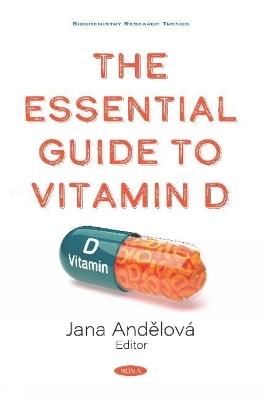
The Essential Guide to Vitamin D
Seiten
2019
Nova Science Publishers Inc (Verlag)
978-1-5361-6600-2 (ISBN)
Nova Science Publishers Inc (Verlag)
978-1-5361-6600-2 (ISBN)
This guide first discusses vitamin D receptor, a member of the superfamily of nuclear steroid/thyroid hormone receptors that can be found in both the cytoplasm and nucleus. It acts mainly as a ligand-dependent DNA-binding transcriptional factor mediating the actions of the biological active form of vitamin D (VD), the metabolite 1α,25[OH]2D3. Vitamin D has a complex role in the human body. Beside the classical effects in bone mineralisation, a significant amount of data regarding the role of this vitamin in cell differentiation, defence mechanism, allergy, inflammation, metabolism and hormonal regulation continue to accumulate. As such, the relevance of these effects for lung disorders is under investigation. Vitamin D is a hormone with pleiotropic effects; it controls calcium homeostasis, immune response, and hemodynamic wall stress. In the last decade, numerous studies have focused on the role of vitamin D levels in cardiovascular disease. In particular, it has been shown that insufficient Vitamin D levels are frequently observed among patients with cardiovascular disease. Additionally, calcitriol, which is also called 1, 25-dihydroxy vitamin D3, is involved in several physiological processes maintaining balanced bone turnover and a healthy bone microenvironment. The beneficial effects of vitamin D on bone biomechanical features are not exclusively attributable to the reduction in non-mineralised bone matrix, but to the osteocyte number and their connectivity, too. Studies have reported that Vitamin D is essential for recovery of hospitalised patients as they are at increased risk of developing/worsening vitamin D deficiency due to lack of availability of sources of the vitamin. Various cognitive disorders have also been associated with hypovitaminosis D. Vitamin D has also been proposed as a risk-modifying factor for many chronic diseases, including multiple sclerosis, schizophrenia, cognitive issues, hypertension, heart disease, diabetes, cancer, psoriasis, and other autoimmune diseases. Vitamin D deficiency is the main cause of osteoporosis and osteomalacia in adults and rickets in children. The low serum of this vitamin is common in patients suffering from cardiovascular, autoimmune, cancer, psoriasis, depression and atherosclerosis disorder. The highly sensitive nature of vitamin D to environmental factors including light, heat, and oxygen, as well as hydrophobicity and acid labile nature, are the major drawbacks that need to be addressed for development of an efficient formulation for vitamin D.
PrefaceThe Vitamin D Receptor (VDR)The Role of Vitamin D Deficiency in the Pathogenesis of Lung DiseasesVitamin D and Cardiovascular DiseasesImplication of Vitamin D Deficiency in Altered Osseous Remodeling and Development of Bone Marrow Edema SyndromeThe Role of Vitamin D in Critically Ill Mechanically Ventilated PatientsVitamin D: A D-Lightful Solution for Neonates (Newer Perspectives on an Older Theme)Lipid Based Drug Delivery Systems for Vitamin DIndex.
| Erscheinungsdatum | 30.12.2019 |
|---|---|
| Verlagsort | New York |
| Sprache | englisch |
| Maße | 155 x 230 mm |
| Gewicht | 288 g |
| Themenwelt | Naturwissenschaften ► Biologie ► Biochemie |
| ISBN-10 | 1-5361-6600-6 / 1536166006 |
| ISBN-13 | 978-1-5361-6600-2 / 9781536166002 |
| Zustand | Neuware |
| Haben Sie eine Frage zum Produkt? |
Mehr entdecken
aus dem Bereich
aus dem Bereich


